Correct you need to move the code itself not deploy a solution
Contoso, Ltd. uses Dynamics 365 Finance. You receive reports of performance issues with the app.
You need to use Performance Timer to investigate the issues.
Which URL should you use?
B
Explanation:
To open the Performance timer, open your webpage with the added parameter debug=develop:
https://yoursite.cloud.test.dynamics.com/en/?cmp=USMF&debug=develop
Reference: https://docs.microsoft.com/en-us/dynamics365/fin-ops-core/dev-itpro/perf-test/performance-timer
HOTSPOT
You need to configure security for the CashDisc form.
What changes should you make? To answer, select the appropriate options in the answer area.
NOTE: Each correct selection is worth one point.
Hot Area: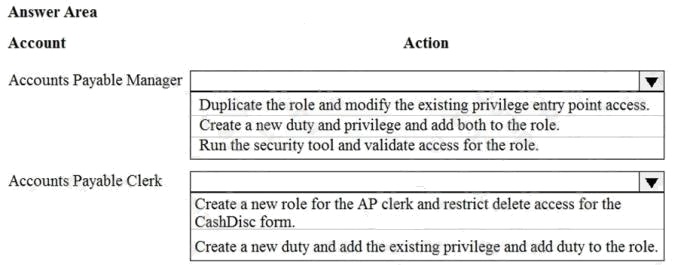
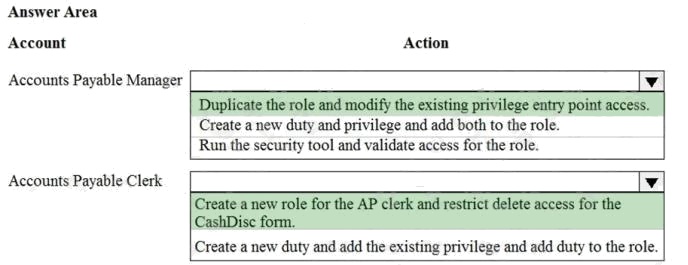
You need to configure security for the Vendor Exclusion List report.
What are two possible ways to achieve this goal? Each correct answer presents a complete solution.
NOTE: Each correct selection is worth one point.
A D
Explanation:
Scenario: Develop necessary security permissions to view and maintain the new Vendor exclusion list functionality and
reporting. Users with maintain rights will be able to create, update, and delete the exclusion list. Permissions must be
assigned to security roles to match company security model.
The privileges are simply a way to grant permissions to an entry point, which can be services, to a duty, role, or even directly
to a user. Typically, we only add entry points to a privilege, such as menu items.
D: You can extend a Security Role or a Security Duty to add new duties/privileges to these elements.
Incorrect Answers:
C: We can't extend security privileges, we would always create a new privilege.
Reference: https://www.oreilly.com/library/view/extending-microsoft-dynamics/9781786467133/40a348f3-0f4c-4d47-a566-
59f3a2e6afa0.xhtml https://docs.microsoft.com/en-us/dynamics365/fin-ops-core/dev-itpro/extensibility/customization-
overlayering-extensions#security-role-and-duty-extensions
You are training a new Dynamics 365 Finance developer.
You need to recommend where asynchronous integrations should be used instead of synchronous integrations.
For which scenario should you recommend asynchronous integration?
A
Explanation:
Reference:
https://docs.microsoft.com/en-us/dynamics365/fin-ops-core/dev-itpro/data-entities/integration-overview
DRAG DROP
A company implements Dynamics 365 Finance and Dynamics 365 Supply Chain Management.
Customers place orders from the company website store or through sales representatives.
You create a Power Platform app to manage sales quotes for sales representatives who do not have direct access to the
Finance and Supply Chain Management environment. The app must meet the following requirements:
Sales representatives must be able to create new customers.
Ensure that only approved products can be sold.
Be available when the sales representatives do not have internet access.
Web sales are imported nightly.
You need to determine a strategy to integrate apps.
What should you use? To answer, drag the appropriate options to the correct app features. Each option may be used once,
more than once, or not at all. You may need to drag the split bar between panes or scroll to view content.
NOTE: Each correct selection is worth one point.
Select and Place:

Explanation:
Reference:
https://docs.microsoft.com/en-us/dynamics365/fin-ops-core/dev-itpro/data-entities/dual-write/dual-write-overview
https://docs.microsoft.com/en-us/powerapps/developer/data-platform/virtual-entities/get-started-ve
https://docs.microsoft.com/en-us/dynamics365/fin-ops-core/dev-itpro/data-entities/develop-composite-data-entities
A company uses Dynamics 365 Finance.
You need to migrate all custom report artifacts from a development environment to a cloud-hosted Tier-1 test environment
that has Visual Studio installed.
Which two actions should you perform? Each correct answer presents part of the solution.
NOTE: Each correct selection is worth one point.
B D
Explanation:
Reference:
https://community.dynamics.com/365/financeandoperations/b/howtodynamics365/posts/how-to-import-and-export-project-in-
dynamics-365
Correct you need to move the code itself not deploy a solution
DRAG DROP
You are a Dynamics 365 Finance developer.
You need to configure integration between Dynamics 365 Finance and other tools.
Which integration types should you use? To answer, drag the appropriate integration types to the correct requirement. Each
integration type may be used once, more than once, or not at all. You may need to drag the split bar between panes or scroll
to view content.
NOTE: Each correct selection is worth one point.
Select and Place:

Explanation:
Box 1: synchronous
A synchronous pattern is a blocking request and response pattern, where the caller is blocked until the callee has finished
running and gives a response.
Box 2: Asynchronous
An asynchronous pattern is a non-blocking pattern, where the caller submits the request and then continues without waiting
for a response.
Box 3: synchronous
Box 4: Asynchronous A typical Batch job.
Reference: https://docs.microsoft.com/en-us/dynamics365/fin-ops-core/dev-itpro/data-entities/integration-overview
DRAG DROP
You need to set up a recurring integration to enable file exchanges between Dynamics 365 Finance and a third-party
system.
In which order should you perform the actions? To answer, move all actions from the list of actions to the answer area and
arrange them in the correct order.
Select and Place: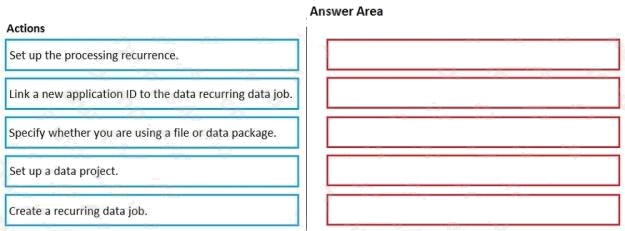
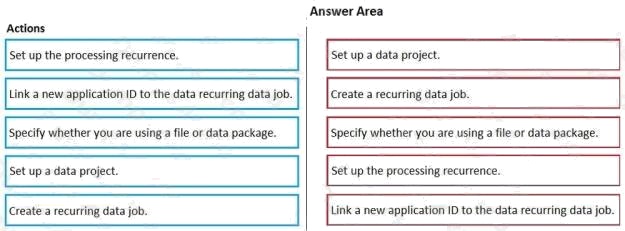
Explanation:
Step 1: Set up a data project
Step 2: Create a recurring data job
1. Create a recurring data job
2. On the Data project page, select Create recurring data job (Step 2)
3. Enter a valid name and a description for the recurring data job.
4. On the Set up authorization policy tab, enter the application ID that was generated for your application, and mark it as
enabled.
5. Expand Advanced options tab, and specify either File or Data package (Step 3)
6. Select Set processing recurrence, and then, in the Define recurrence dialog box, set up a valid recurrence for your data
job (Step 4)
Step 3: Specify whether you are using a file or data package.
Step 4: Set up the processing recurrence
Step 5: Link a new application ID to the data recurring data job
You can use integration REST endpoints to integrate with the client, submit documents (import), or poll available documents
for download (export).
These endpoints support OAuth.
Reference: https://docs.microsoft.com/en-us/dynamics365/fin-ops-core/dev-itpro/data-entities/recurring-integrations
DRAG DROP
A company plans to deploy Dynamics 365 Unified Operations.
You need to recommend deployment options for the company.
What should you recommend? To answer, drag the appropriate deployment options to the correct application requirement.
Each deployment option may be used once, more than once, or not at all. You may need to drag the split bar between panes
or scroll to view content.
NOTE: Each correct selection is worth one point.
Select and Place: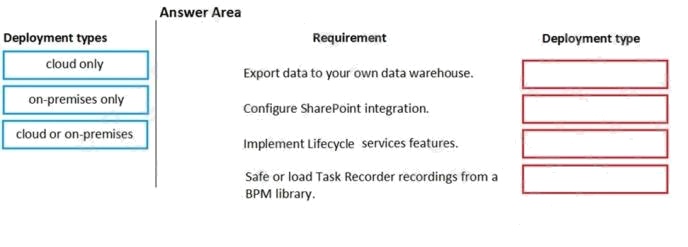
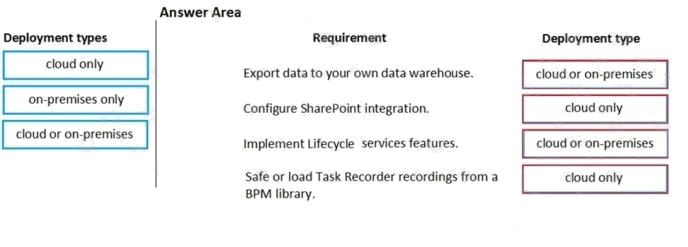
Explanation:
Reference: https://docs.microsoft.com/en-us/dynamics365/fin-ops-core/fin-ops/get-started/cloud-prem-comparison
You are training a new Dynamics 365 Finance developer.
You need to recommend where asynchronous integrations should be used instead of synchronous integrations.
For which scenario should you recommend asynchronous integration?
C
Explanation:
Reference:
https://docs.microsoft.com/en-us/dynamics365/fin-ops-core/dev-itpro/data-entities/integration-overview
HOTSPOT
You are a Dynamics 365 Finance developer.
You need to export data from all products into a data package every day at 2 a.m. You open the Data Management
workspace.
How should you complete the process? To answer, select the appropriate options in the answer area.
NOTE: Each correct selection is worth one point.
Hot Area: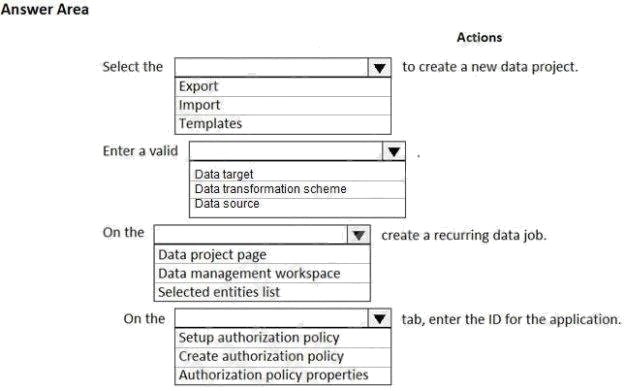
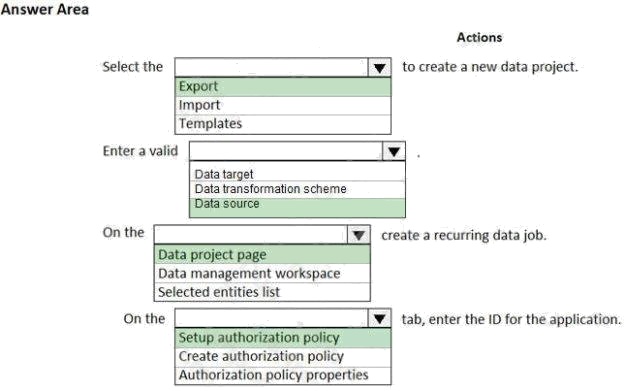
Explanation:
Box 1: Export
Select the Import or Export (in this case) tile to create a new data project.
Box 2: Data source
Enter a valid job name, data source, and entity name.
Box 3: Data project page
O the Data project page, select Create recurring data job.
Box 4: Setup authorization policy
In the Set up authorization policy tab, enter the application ID that was generated for your application, and mark it as
enabled.
Reference:
https://docs.microsoft.com/en-us/dynamics365/fin-ops-core/dev-itpro/data-entities/recurring-integrations
Implement Security and Optimize Performance
An organization has two million customers that are part of the International customer group.
Validation must occur when customer records are updated. For all customers where the value of the customer group field is
international, you must the delivery mode to Air.
You need to update the customer records.
Which two code segments can you use? Each correct answer presents a complete solution.
NOTE: Each correct selection is worth one point.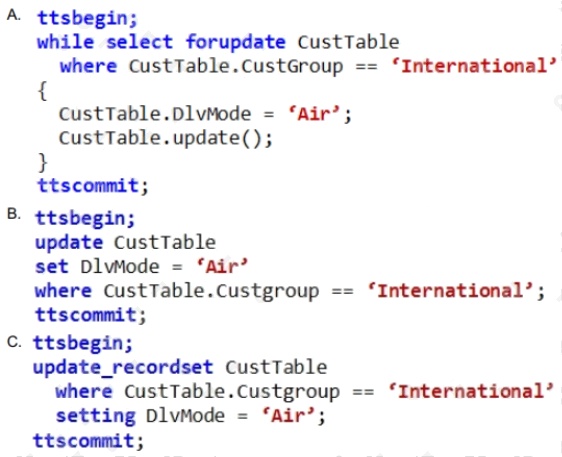
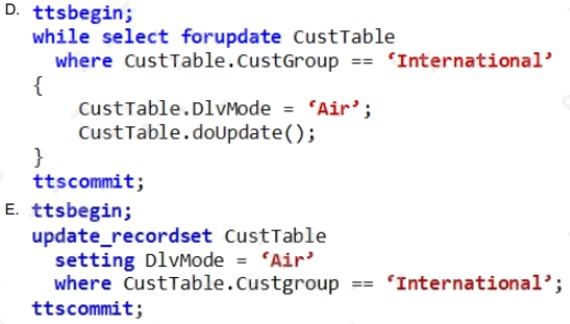
D E
Explanation:
This is Update and Update_RecordSet Code sample. Result of both will be same .
TestTable TestTable;
//Update_Recordset
update_recordset TestTable setting Name ="New Enterprises" where TestTable.Accountnum =="uS-027";
//Update ttsBegin;
while select forupdate TestTable where TestTable.Accountnum =="uS-027"
{
TestTable.Name ="New Enterprises";
TestTable.update();
}
ttsCommit; info("OK");
Reference: https://community.dynamics.com/ax/b/technicaltutorialsformsdynamicsax2012/posts/update-and-update-
recordset-code-sample-in-ax-2012
You are a Dynamics 365 Finance developer.
You make changes to an existing class.
You need to compare the code that is in source control with the updated class. In Visual Studio, you display Team Explorer.
What are three possible ways to achieve the goal? Each correct answer presents a complete solution.
NOTE: Each correct selection is worth one point.
A B D
Explanation:
Example: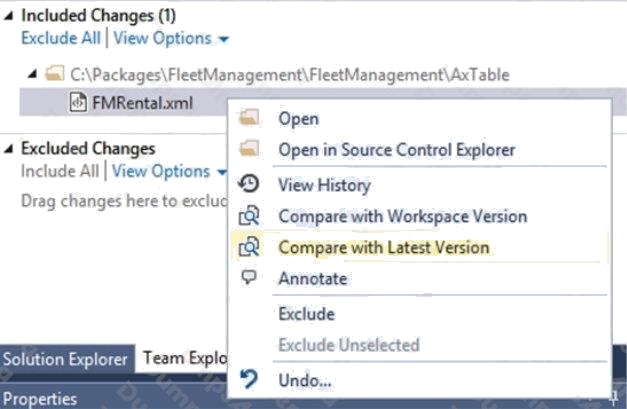
D: The diff tool of Visual Studio is very good to compare two files.
It compares, and if it is possible, displays differences between two files, files in two folders, or a shelveset and a local or a
server file.
Syntax:
tf diff[erence] itemspec [/version:versionspec] [/type:filetype] [/format:format [/ignorespace] [/ignoreeol] [/ignorecase]
[/recursive] [/options][/noprompt][/login:username,[password]]
Incorrect Answers:
E: vsdiffmerge is used for merging.
Reference: https://docs.microsoft.com/en-us/azure/devops/repos/tfvc/difference-command
A company uses Dynamics 365 Finance.
You have an entity named VendVendorV2Entity. You add a new column to the entity.
You need to ensure that the new column is available in the entity for data transfer activity.
Which two actions should you perform? Each correct answer presents part of the solution.
NOTE: Each correct selection is worth one point.
A B
Explanation:
Using the configuration key metadata built during entity refresh list, run time validations are performed in the following use
cases. When user clicks Validate on the entity list. When the user generates mapping.

Reference: https://docs.microsoft.com/en-us/dynamics365/fin-ops-core/dev-itpro/data-entities/data-entities
You are training a new Dynamics 365 Finance developer.
You need to recommend where asynchronous integrations should be used instead of synchronous integrations.
For which scenario should you recommend asynchronous integration?
C
Explanation:
Reference:
https://docs.microsoft.com/en-us/dynamics365/fin-ops-core/dev-itpro/data-entities/integration-overview#synchronous-vs-
asynchronous-integration-patterns